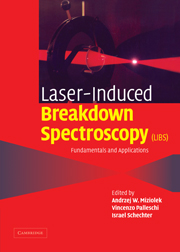Book contents
- Frontmatter
- Contents
- List of contributors
- Preface
- 1 History and fundamentals of LIBS
- 2 Plasma morphology
- 3 From sample to signal in laser-induced breakdown spectroscopy: a complex route to quantitative analysis
- 4 Laser-induced breakdown in gases: experiments and simulation
- 5 Analysis of aerosols by LIBS
- 6 Chemical imaging of surfaces using LIBS
- 7 Biomedical applications of LIBS
- 8 LIBS for the analysis of pharmaceutical materials
- 9 Cultural heritage applications of LIBS
- 10 Civilian and military environmental contamination studies using LIBS
- 11 Industrial applications of LIBS
- 12 Resonance-enhanced LIBS
- 13 Short-pulse LIBS: fundamentals and applications
- 14 High-speed, high-resolution LIBS using diode-pumped solid-state lasers
- 15 Laser-induced breakdown spectroscopy using sequential laser pulses
- 16 Micro LIBS technique
- 17 New spectral detectors for LIBS
- 18 Spark-induced breakdown spectroscopy: a description of an electrically generated LIBS-like process for elemental analysis of airborne particulates and solid samples
- Index
- References
12 - Resonance-enhanced LIBS
Published online by Cambridge University Press: 08 August 2009
- Frontmatter
- Contents
- List of contributors
- Preface
- 1 History and fundamentals of LIBS
- 2 Plasma morphology
- 3 From sample to signal in laser-induced breakdown spectroscopy: a complex route to quantitative analysis
- 4 Laser-induced breakdown in gases: experiments and simulation
- 5 Analysis of aerosols by LIBS
- 6 Chemical imaging of surfaces using LIBS
- 7 Biomedical applications of LIBS
- 8 LIBS for the analysis of pharmaceutical materials
- 9 Cultural heritage applications of LIBS
- 10 Civilian and military environmental contamination studies using LIBS
- 11 Industrial applications of LIBS
- 12 Resonance-enhanced LIBS
- 13 Short-pulse LIBS: fundamentals and applications
- 14 High-speed, high-resolution LIBS using diode-pumped solid-state lasers
- 15 Laser-induced breakdown spectroscopy using sequential laser pulses
- 16 Micro LIBS technique
- 17 New spectral detectors for LIBS
- 18 Spark-induced breakdown spectroscopy: a description of an electrically generated LIBS-like process for elemental analysis of airborne particulates and solid samples
- Index
- References
Summary
Introduction to resonance-enhanced LIBS
An analytical technique based on resonance-enhanced laser-induced plasma spectroscopy is reviewed in this chapter. The technique differs from conventional LIBS in that the plasmas are formed and heated by photoresonant excitation of the host species in the plume. The chaotic explosion and intense continuum emissions associated with thermal breakdown are therefore avoided. Pilot cases of solid and liquid analysis are discussed. The key experimental parameters are identified, the plasma dynamics are explained, and the improvements over non-resonant LIBS are reported. For solid samples, the ratio of the analyte line signal to the background continuum noise increased by an order of magnitude typically. For aqueous samples, the relative limits of detection (LODs) improved by 20× to 1000× for the range of elements tested. The absolute LODs were low enough to enable the measurement of Na and K in single human erythrocytes.
Laser-induced breakdown spectroscopy (LIBS) is a versatile technique for elemental analysis. While it is finding niche applications where alternative technology is inferior or simply does not exist, it is also challenged with ever more difficult analytical tasks (numerous examples of which can be found elsewhere in this book). Among the many problems encountered, some are specific and require solutions tailored for the particular application. But there are also general problems, such as the reproducibility and sensitivity issues associated with LIBS analysis.
The universality of the problem arises from the very nature of laser-induced breakdown.
- Type
- Chapter
- Information
- Laser Induced Breakdown Spectroscopy , pp. 440 - 476Publisher: Cambridge University PressPrint publication year: 2006

